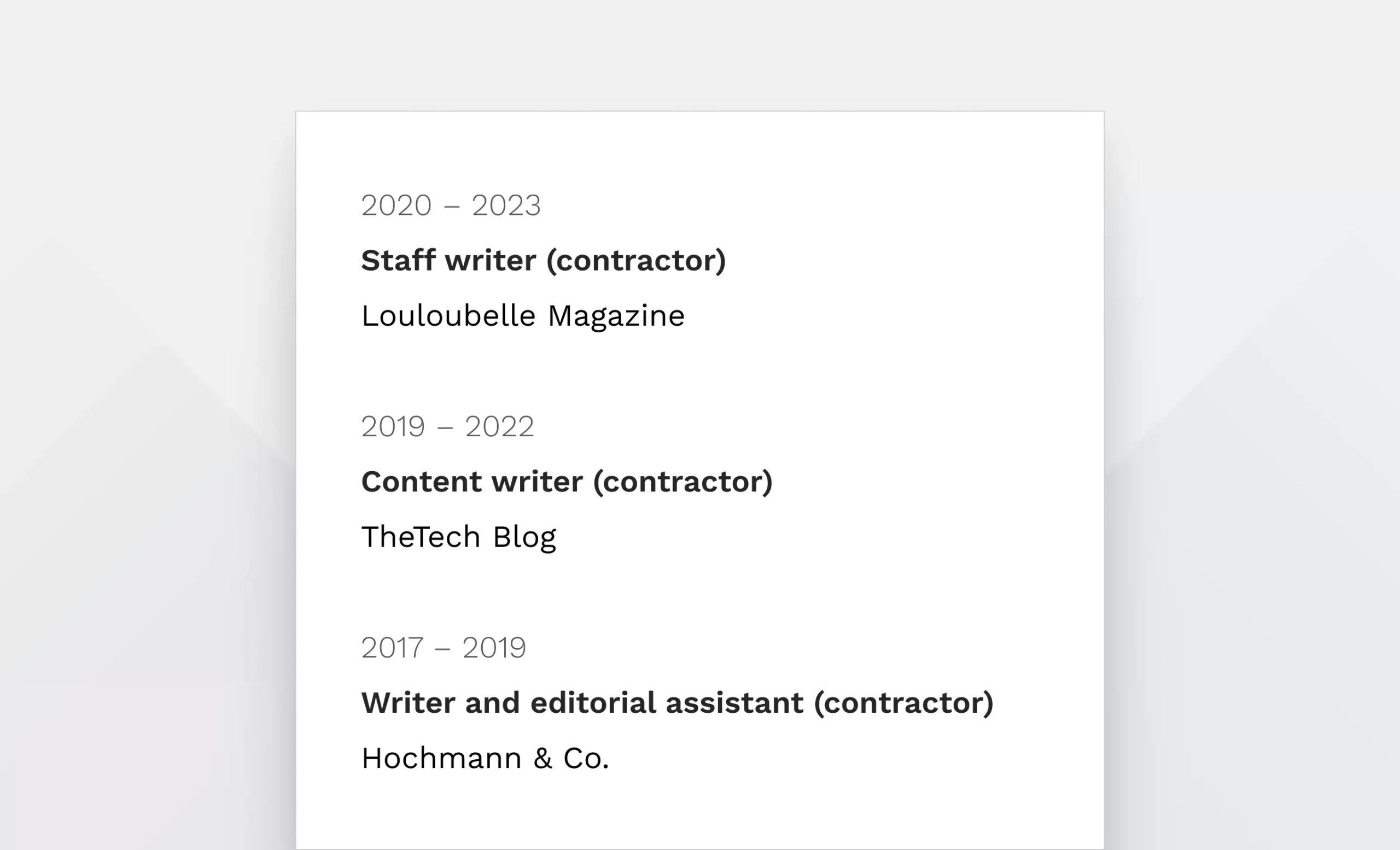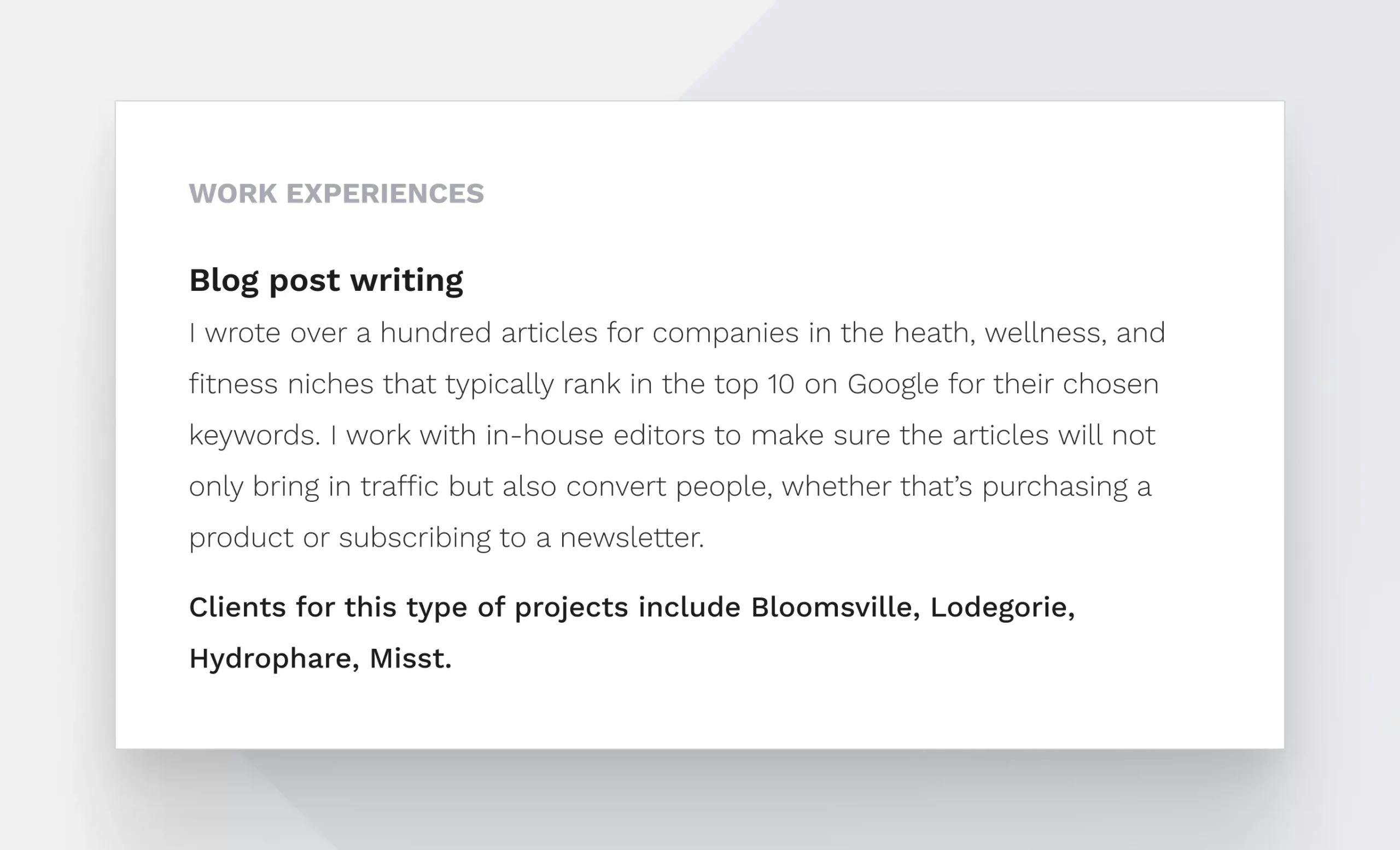The best weapon in a freelance writer’s arsenal will always be their writing portfolio. But some companies still ask for CVs from their potential contractors —and writing one is not as straightforward as for an in-house employee. Don’t worry, we’re here to help! We’ll show you how to write a strong freelance writer resume, illustrated with examples of resume summaries, work experience sections, and more.
Keep on reading to find answers to all essential writer resume questions, and get in touch with us via email or TikTok if there’s anything left unanswered.
What skills should be on your freelance writer resume?
When looking at your resume, potential clients want to know two things: what you’re good at and how you’ve proven that before. You can do the former by showcasing your top skills there. But which ones should you add?
Think about it from an employer’s perspective. They’ll want to know what type of tasks you can do, what tools you know how to use, and if working with you as a person, potentially a part of a team will be easy. So add 3-4 skills for each of these categories.
Here’s an example of a freelance content writer’s skills:
Professional skills
- Blog post writing
- SEO optimization
- Research and analytics
- Web page copywriting
Tools & software
- Ahrefs for SEO
- Google Analytics for stats
- Hemingway for writing
Personal skills
- Intercultural communication
- Teamwork and collaboration
- Efficient time management
What’s the best resume format for freelance writers?
Before we get into the “how to write the resume” part, we need to stop for a second and talk about the resume format. Because for freelancers, the traditional reverse chronological resume format might not work so well.
When does the reverse chronological resume format work for freelancers?
If you’ve been in contract steadily, for longer periods of time, for a smaller number of clients, you could still use the reverse chronological format. Then your work experience section might look something like this:

2020-2023
Staff writer (contractor)
Louloubelle Magazine
2019-2022
Content writer (contractor)
TheTech Blog
2017-2019
Writer and editorial assistant (contractor)
Hochmann & Co.
And if you had multiple smaller clients or projects on the side, you can just list them all afterward, without noting exact time periods.
What would be a better resume format for freelance writers then?
For writers with many more freelance projects, we recommend a functional resume format instead.
This one puts the skills and types of projects into the spotlight, without breaking it down by clients or years. Let us show you an example to better explain it.

Work experiences
Blog post writing: I wrote over a hundred articles for companies in the health, wellness, and fitness niches that typically rank in the top 10 on Google for their chosen keywords. I work with in-house editors to make sure the articles will not only bring in traffic but also convert people, whether that’s purchasing a product or subscribing to a newsletter.
Clients for this type of projects include Bloomsville, Lodegorie, Hydrophare, Misst
How to write a freelance writer resume
And now the fun part. How do you actually write that freelance writer resume? Do you just list your skills and work experience like we outlined above and you’re done?
Well, not really. There are a few more sections you need to include —these are what we’re going to review now.
Freelance writer resume summary examples & how to write yours
Following your name and contact info at the top of the CV, your resume summary will be the first thing people read. So it comes as no surprise when we say it’s a really important part and that you should strive to nail it.
What is a resume summary?
The resume summary is a short paragraph concisely explaining your career, including your work experiences and top skills. Its aim is to catch the attention of recruiters and show whether you might be a good fit for the company, without having to read through the whole CV.
5 resume summary examples for writers
Now that we got the definition out of the way, let’s see a few examples.
1. Experienced freelance writer with a passion for creating compelling content. With five years of experience writing in a variety of niches, including health, finance, and technology, I bring outstanding skills and expertise to every project. I specialize in crafting engaging blog posts and social media content that resonates with the brand’s target audience and drives engagement.
2. Award-winning freelance writer with a knack for storytelling. I’ve been recognized by industry leaders for my ability to craft compelling narratives that capture readers' attention with every piece I write. Whether it's a feature article, a case study, or a marketing campaign, I know how to create content that connects with audiences and makes people take action.
3. Organized and efficient freelance writer with a talent for meeting deadlines. With a background in journalism, I am used to producing high-quality content while working under tight deadlines. I am skilled in doing research, interviewing sources, and translating complex information into clear and concise language.
4. Versatile freelance writer skilled in adapting to diverse audiences and topics. With a background in both creative and technical writing, I can communicate complex ideas in clear, engaging language. I have written for clients in industries ranging from healthcare to hospitality and can write in a variety of formats and styles.
5. Expert content strategist and freelance writer. As a former content marketing manager, I know how content fits into broader marketing strategies. I can develop content calendars, conduct keyword research, and optimize content for search engines. As a writer, I bring this strategic mindset to every project, ensuring that each piece of content is designed to achieve the set KPIs and business objectives.
Make sure to be concise and include your strongest skills and most impressive work experiences. If you can, you can also add some stats to show what an impact your writing made.
Don’t forget to link to your writing portfolio
The resume summary, work experience section, and your list of skills are perfect for telling people what you do and what you’re good at. But that doesn’t have quite the same effect as actually showing them how you do it. And that’s what your writing portfolio is all about.
If you’re not adding a link to your portfolio in your resume (don’t worry, PDFs these days have clickable links), you’re leaving money on the table. If your CV got someone’s attention (which is its primary purpose), they’ll be happy to find out more. So make it easy for them!
How to create a writing portfolio
If you don’t have a writing portfolio yet, you should find a platform that makes it quick and easy to put one together. Just make sure it’s one that also helps you make it look professional.
For that, check out Copyfolio, which is a portfolio website builder designed for writers and marketers. With easy-to-use templates, a visual editor, and profession-based content generation for your site, you can create a stunning portfolio in just about 30 minutes.
To learn more, check out its list of features, explore portfolio examples and templates, or learn how to build a proper freelance writer website (with even more examples)!
Do you need an education section as a freelance writer?
Last, but not least, since freelancer resumes are already unconventional, comes the question: do you even need an education section in there?
The answer, as it often is, it depends.
List your educational background if you…
- Have a Bachelor’s or Master’s degree in English, writing, journalism, communications, or marketing
- Completed certifications well-known and reputable in the writing world
- Did courses or earned a degree in a field related to the companies you’re applying to (e.g. if you have a healthcare-related degree and want to be a freelance health writer)
Skip the education section if you…
- Don’t have any English or writing-related degrees or certifications
- Have an impressive list of previous clients, who are well-known in their industry
- Created a writing portfolio that’ll absolutely sweep them off their feet
The overall goal of the education background section is to help convince potential employers. So if yours doesn’t help your case at all, it’s better to just leave it out.
Where to create your freelance writer resume
When you know exactly what to write, the next logical question is: how do you make it presentable? There are three ways to go about it:
- Create a PDF resume yourself. Using a design software like Canva (or Adobe InDesign, if you’re a real pro) and potentially a resume template, you can design a fully custom and on-brand CV for yourself —then export it as a PDF.
- Use a resume builder. There are resume-builder tools out there that were developed for this exact purpose. They help you with formatting and writing prompts, making resume creation as painless as possible.
- Add it to your portfolio website. In Copyfolio, there’s a dedicated resume section that makes it easy to showcase your resume without any design software involved. The style and layout are given, all you have to do is type it in.

Whichever way you choose, follow our tips, and you’ll surely write a resume that’ll sweep recruiters off their feet. Good luck!


